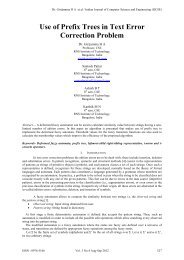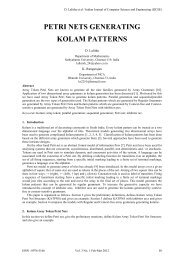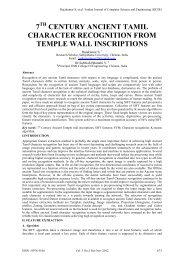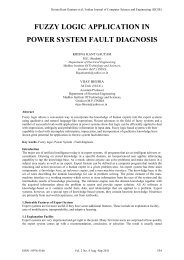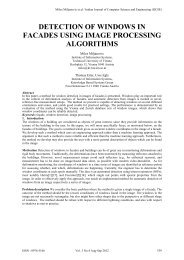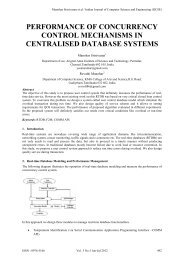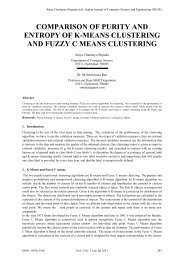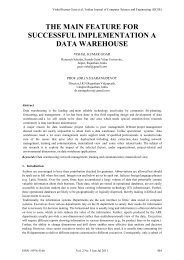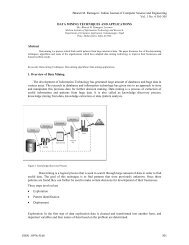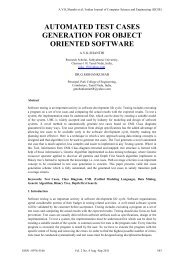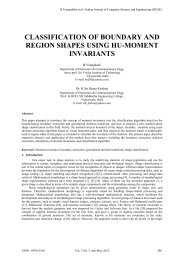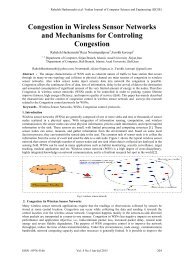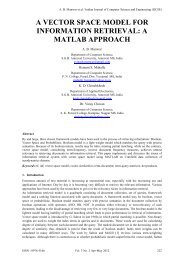adapting rule based machine translation from english to bangla
adapting rule based machine translation from english to bangla
adapting rule based machine translation from english to bangla
You also want an ePaper? Increase the reach of your titles
YUMPU automatically turns print PDFs into web optimized ePapers that Google loves.
Judith Francisca et al./ Indian Journal of Computer Science and Engineering (IJCSE)Table 1: Comparison of the similarities between different languages.LanguageWordEnglish month mother new night nose threeLatin mensis mater novus nox nasus tresSanskrit mãs matar nava nakt nãs trayasBangla Mash mata nobo ratri naakh tinNatural Language Processing (NLP) is quite a difficult task. There were many researches in the field oflanguage <strong>translation</strong> but there is no fully successful language <strong>translation</strong> <strong>machine</strong> so far. Since it is a HumanLanguage Technology (HLT), there are lots of varieties and lots of opportunities for research. It is not possible<strong>to</strong> work on the whole language <strong>translation</strong> process <strong>to</strong>gether. Therefore, it is segmented in<strong>to</strong> many parts. But, thefact is, most of them choose a part of the source language <strong>to</strong> be translated <strong>to</strong> the target language. For example, inour paper the source language is English and the target language is Bangle. There are varieties types ofsentences both in English and Bangla language. In this paper, we have kept all types of sentences though thetypes of sentences are not the main issues of our thesis. We have mainly focused on the process of language<strong>translation</strong> and the effectiveness of the language <strong>translation</strong>. The efficiency is measured by different methods. Inthis paper, we can adapt a new system so that it will be 100% efficient at least theoretically.The paper is organized as follows: Section II discusses the background of the research. Section III explainsthe problem statements. Solution Frameworks are analyzed in Section IV, while the methods for improving <strong>to</strong>the adaptive system are provided in Section V. Finally, Section VI draws some conclusion and provides someremarks on the future works.2. BackgroundA very few work has been done on English <strong>to</strong> Bangla language <strong>translation</strong> both in Bangladesh andWest Bengal of India. A hybrid scheme is shown in [3]. Only the present indefinite and present continuousforms of English sentences are concerned in [4]. They represent a simple algorithm for language <strong>translation</strong>.Using Artificial Intelligence (AI) a Natural Language Processing (NLP) algorithm is proposed in [5]. In [6],Cockey-Younger-Kasami (CYK) algorithm is used for language <strong>translation</strong>. The main change they brought wasthat they used normal parse tree than the Chomsky Normal Form (CNF) parse tree because they proved thatsome problems arose during transfer <strong>from</strong> English parse tree <strong>to</strong> Bangla parse tree. Fig. 1 shows pars tree forEnglish and Bangla sentence. Morphological analysis is done in [7] where morphemes means minimal unit ofmeaning of grammatical analysis. A phrasal Example Based Machine Translation (EBMT) is represented in [8].Another paper [9] concentrated specially on prepositions of English. In other languages, excluding Bangla it isinteresting <strong>to</strong> study Machine Translation (MT) because it will show some other efficient techniques for language<strong>translation</strong>. This type of research is Spanish <strong>to</strong> English language <strong>translation</strong> [10]. Using five (5) components andthree (3) algorithms they have done the language <strong>translation</strong>. Components are i) PENMAN Upper Model, ii)ONTOS Model, iii) Longman’s Dictionary of Contemporary English (LDOCE), iv) WordNet, v) Harper CollinsSpanish English Bilingual Dictionary.Figure 1: Parse tree for English and Bangla sentence.ISSN : 0976-5166 Vol. 2 No. 3 Jun-Jul 2011 335



